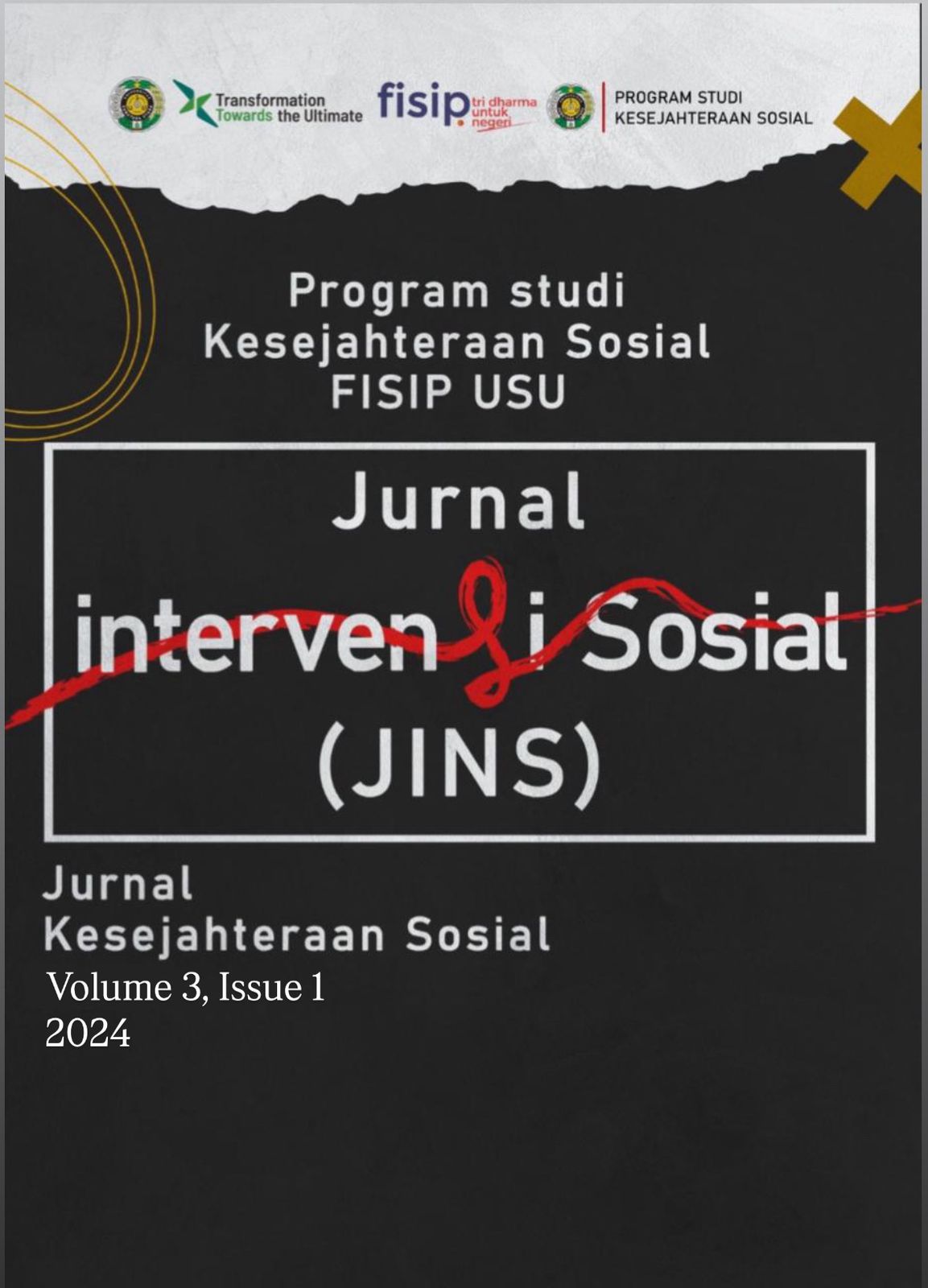Membongkar Strategi Komunikasi Efektif: Analisis Kasus Pada Pekerja Sosial di Lingkungan Urban
DOI:
https://doi.org/10.32734/intervensisosial.v3i1.16129Keywords:
Strategy, effective communication, social workers, urbanAbstract
This article aims to explore effective communication strategies implemented by social workers in urban environments through a systematic literature review (SLR) approach. The research employs a qualitative method alongside the SLR approach. Primary sources for this study are articles specifically concerning the theme, while secondary sources include supporting articles, books, and reports. The data collection technique used in this research is document analysis and literature review. Data analysis was conducted using the Miles and Huberman model, which involves data reduction, data display, and conclusion drawing. The findings indicate that communication technology plays a vital role in enhancing interactions between social workers and their clients. The success of communication also heavily relies on cultural sensitivity and the social workers' ability to tailor their messages to the diverse needs and contexts of their clients. Challenges such as building trust and adapting to rapid changes, especially under pandemic conditions, are the primary focus of the discussion. The discussion in this article reveals that effective communication in urban social work involves more than the mere transfer of information; it also encompasses relationship building, client empowerment, and strategy adaptation in response to crises. Successful strategies are those that combine the use of technology with a humanity-based approach to support client autonomy and activate their potential for positive social change.
Downloads
References
Akhavan, M., Mariotti, I., Astolfi, L., & Canevari, A. (2019). Coworking Spaces and New Social Relations: A Focus on the Social Streets in Italy. Urban Science, 3(1). https://doi.org/10.3390/urbansci3010002
Baker, M., Berens, K. A., Williams, S., Bruer, K. C., Evans, A. D., & Price, H. L. (2021). The Impact of COVID-19 on Social Work Practice in Canada: A Comparison of Urban and Rural Contexts. Journal of Comparative Social Work, 16(2). https://doi.org/10.31265/JCSW.V16I2.382
Barus, R. K. I., Dewi, S. S., & Khairuddin, K. (2020). Komunikasi Interpersonal Tenaga Kerja Indonesia dan Anak. Journal of Education, Humaniora and Social Sciences (JEHSS), 3(2). https://doi.org/10.34007/jehss.v3i2.310
Castillo de Mesa, J., López Peláez, A., Méndez-DomÃnguez, P., & Kirwan, G. (2022). Digital Communication Engaged in by Spanish Associations of Social Workers in Social Networking Sites: Coalition, Hierarchisation, or Isolation? Revista Espanola de Investigaciones Sociologicas, 178. https://doi.org/10.5477/cis/reis.178.39
Christens, B. D. (2019). Community Power and Empowerment. In Community Power and Empowerment. https://doi.org/10.1093/oso/9780190605582.001.0001
Creswell, J. W. (2020). Penelitian Kualitatif & Desain Riset : Memilih di Antara Lima Pendekatan. In Mycological Research.
Dalimunthe, M. A., Pallathadka, H., Muda, I., Devi Manoharmayum, D., Habib Shah, A., Alekseevna Prodanova, N., Elmirzayevich Mamarajabov, M., & Singer, N. (2023). Challenges of Islamic education in the new era of information and communication technologies. HTS Teologiese Studies / Theological Studies, 79(1). https://doi.org/10.4102/hts.v79i1.8608
Fauzan, I., Arifin, A., Dalimunthe, M. A., & Rahmadani, S. (2023). The configuration of ethnic and religious relations towards the 2024 general election: A case study in Medan, Indonesia. Multidisciplinary Science Journal, 6(2), 2024006. https://doi.org/10.31893/multiscience.2024006
Fineberg, I. C. (2010). Social work perspectives on family communication and family conferences in palliative care. In Progress in Palliative Care (Vol. 18, Issue 4). https://doi.org/10.1179/096992610X12624290277105
Gustafson, E. L., Atkins, M., & Rusch, D. (2018). Community Health Workers and Social Proximity: Implementation of a Parenting Program in Urban Poverty. American Journal of Community Psychology, 62(3–4). https://doi.org/10.1002/ajcp.12274
Hammock, A., Pandolfelli, G., Samuel, T., Fils-Aimé, P., Grande, M., D’Ambrosion, M., Murphy, M., Kaur, S., Logan, J., Feuerstein-Simon, R., Cannuscio, C., & Benz Scott, L. (2023). Understanding how suburban public librarians respond to the health and social needs of communities. Library and Information Science Research, 45(1). https://doi.org/10.1016/j.lisr.2022.101217
He, S., Yang, L., & Min, Q. (2020). Community participation in nature conservation: The Chinese experience and its implication to national park management. Sustainability (Switzerland), 12(11). https://doi.org/10.3390/su12114760
Henley, L. J., Henley, Z. A., Hay, K., Chhay, Y., & Pheun, S. (2021). Social Work in the Time of COVID-19: A Case Study from the Global South. British Journal of Social Work, 51(5). https://doi.org/10.1093/bjsw/bcab100
Hilty, D. M., Groshong, L. W., Coleman, M., Maheu, M. M., Armstrong, C. M., Smout, S. A., Crawford, A., Drude, K. P., & Krupinski, E. A. (2023). Best Practices for Technology in Clinical Social Work and Mental Health Professions to Promote Well-being and Prevent Fatigue. Clinical Social Work Journal, 51(3). https://doi.org/10.1007/s10615-023-00865-3
Hu, T., Li, L., Lin, C., Yang, Z., Chow, C., Lu, Z., & You, C. (2022). An Analysis of the Willingness to the COVID-19 Vaccine Booster Shots among Urban Employees: Evidence from a Megacity H in Eastern China. International Journal of Environmental Research and Public Health, 19(4). https://doi.org/10.3390/ijerph19042300
Husz, I., Kopasz, M., & Medgyesi, M. (2022). Social Workers’ Causal Attributions for Poverty: Does the Level of Spatial Concentration of Disadvantages Matter? Social Indicators Research, 162(3). https://doi.org/10.1007/s11205-021-02868-4
Indainanto, Y. I., Dalimunthe, M. A., Sazali, H., Rubino, & Kholil, S. (2023). Islamic Communication in Voicing Religious Moderation as an Effort to Prevent Conflicts of Differences in Beliefs. Pharos Journal of Theology, 104(4). https://doi.org/10.46222/pharosjot.104.415Jahans-Baynton, K., & Grealish, A. (2022). Safeguarding communications between multiagency professionals when working with children and young people: A qualitative study. Journal of Child and Adolescent Psychiatric Nursing, 35(2). https://doi.org/10.1111/jcap.12363
Joseph, R. (2020). The theory of empowerment: A critical analysis with the theory evaluation scale. Journal of Human Behavior in the Social Environment, 30(2). https://doi.org/10.1080/10911359.2019.1660294
Ju, B., Dai, H. M., & Sandel, T. L. (2023). Resilience and (Dis)empowerment: Use of Social Media Among Female Mainland Low-Skilled Workers in Macao During the COVID-19 Pandemic. SAGE Open, 13(1). https://doi.org/10.1177/21582440231160480
Kasperiuniene, J., & Zydziunaite, V. (2019). A Systematic Literature Review on Professional Identity Construction in Social Media. SAGE Open, 9(1). https://doi.org/10.1177/2158244019828847
Kontos, P., Grigorovich, A., Nowrouzi, B., Sharma, B., Lewko, J., Mollayeva, T., & Colantonio, A. (2017). A qualitative exploration of work-related head injury: Vulnerability at the intersection of workers’ decision making and organizational values. BMC Public Health, 17(1). https://doi.org/10.1186/s12889-017-4823-5
MacDonald, M., Wright, A. C., Taylor-Beswick, A., Gillespie, K., & Collings, S. (2023). Digital Relationality, Rights, Resilience: Conceptualising a Digital Social Ecology for Children’s Birth Family Relationships When in Care or Adopted. The British Journal of Social Work, 53(1). https://doi.org/10.1093/bjsw/bcac140
Miles, M. B., & Huberman, A. M. (2016). Miles, M. B., & Huberman, A. M. (1994). Qualitative data analysis: An expanded sourcebook. In Nursing standard (Royal College of Nursing (Great Britain) : 1987) (Vol. 30, Issue 25).
Ne’Matullah, K. F., Pek, L. S., & Roslan, S. A. (2021). Investigating communicative barriers on construction industry productivity in Malaysia: An overview. International Journal of Evaluation and Research in Education, 10(2). https://doi.org/10.11591/ijere.v10i2.21163
OrgambÃdez, A., Millán, M., DomÃnguez, L., & Borrego, Y. (2022). Structural Empowerment, Burnout, and Job Satisfaction: Comparison of Public and Private Social Service Centers. Human Service Organizations Management, Leadership and Governance, 46(1). https://doi.org/10.1080/23303131.2021.1967823
Petzold, M. B., Plag, J., & Ströhle, A. (2020). Dealing with psychological distress by healthcare professionals during the COVID-19 pandemia. In Nervenarzt (Vol. 91, Issue 5). https://doi.org/10.1007/s00115-020-00905-0
Pilarska, J. (2021). The constructivist paradigm and phenomenological qualitative research design. In Research Paradigm Considerations for Emerging Scholars. https://doi.org/10.21832/9781845418281-008
Premji, S., Begum, M., & Medley, A. (2022). Language Accommodations in Workers’ Compensation: Comparing Ontario and Quebec. New Solutions, 31(4). https://doi.org/10.1177/10482911211053020
Rambe,R.F. AL. K., Ritonga, A.R., Dalimunthe,M.A. (2023). Komunikasi Publik Pemerintah Kota Medan Dalam Pengalihan Kewenangan Kebijakan Terkait UU No. 23 tahun 2014. KomunikA. 19(01), 39-44. https://doi.org/10.32734/komunika.v19i01.11411
Redondo-Sama, G., Matulic, V., Munté-Pascual, A., & Vicente, I. de. (2020). Social work during the covid-19 crisis: Responding to urgent social needs. Sustainability (Switzerland), 12(20). https://doi.org/10.3390/su12208595
Retnosari, L. (2023). Kemiskinan di Perkotaan. Kompas.Id. https://www.kompas.id/baca/opini/2023/09/19/kemiskinan-di-perkotaan
Roy, D., Saroj, S., & Pradhan, M. (2022). Nature of employment and outcomes for urban labor: evidence from the latest labor force surveys in India. Indian Economic Review, 57(1). https://doi.org/10.1007/s41775-022-00131-2
Shelley, C. (2023). : Poverty, Solidarity, and Poor-Led Social Movements . Ethics, 133(4). https://doi.org/10.1086/724532
Sikumbang, A. T., Dalimunthe, M. A., Kholil, S., & Nasution, N. F. Digital Da'wah Indonesia Ulema in the Discourse of Theology. Pharos Journal of Theology. 105(1). 1-14. https://doi.org/10.46222/pharosjot.1051Sousa, I. C., Ramos, S., & Carvalho, H. (2019). Age-diversity practices and retirement preferences among older workers: A moderated mediation model of work engagement and work ability. Frontiers in Psychology, 10(AUG). https://doi.org/10.3389/fpsyg.2019.01937
Straughan, E. R., & Bissell, D. (2022). Curious encounters: the social consolations of digital platform work in the gig economy. Urban Geography, 43(9). https://doi.org/10.1080/02723638.2021.1927324
Sumardjo, S., Firmansyah, A., & Dharmawan, L. (2023). Social Transformation in Peri-Urban Communities toward Food Sustainability and Achievement of SDGs in the Era of Disruption. Sustainability (Switzerland), 15(13). https://doi.org/10.3390/su151310678
Van Zoonen, W., Treem, J. W., & Sivunen, A. (2022). An analysis of fear factors predicting enterprise social media use in an era of communication visibility. Internet Research, 32(7). https://doi.org/10.1108/INTR-05-2021-0341
Wang, J. S. H. (2023). Nudging for Social Change: Promises and Cautions for Social Workers to Apply Behavioural Economic Tools. British Journal of Social Work, 53(2). https://doi.org/10.1093/bjsw/bcac153
Weyant, E. (2022). Research Design: Qualitative, Quantitative, and Mixed Methods Approaches, 5th Edition. Journal of Electronic Resources in Medical Libraries, 19(1–2). https://doi.org/10.1080/15424065.2022.2046231
Zhu, M., Song, X., & Chen, W. (2022). Impact of Social Capital on Land Arrangement Behavior of Migrant Workers in China. Journal of Economic Analysis. https://doi.org/10.58567/jea01010003
Downloads
Published
How to Cite
Issue
Section
License
Copyright (c) 2024 Jurnal Intervensi Sosial

This work is licensed under a Creative Commons Attribution-ShareAlike 4.0 International License.








